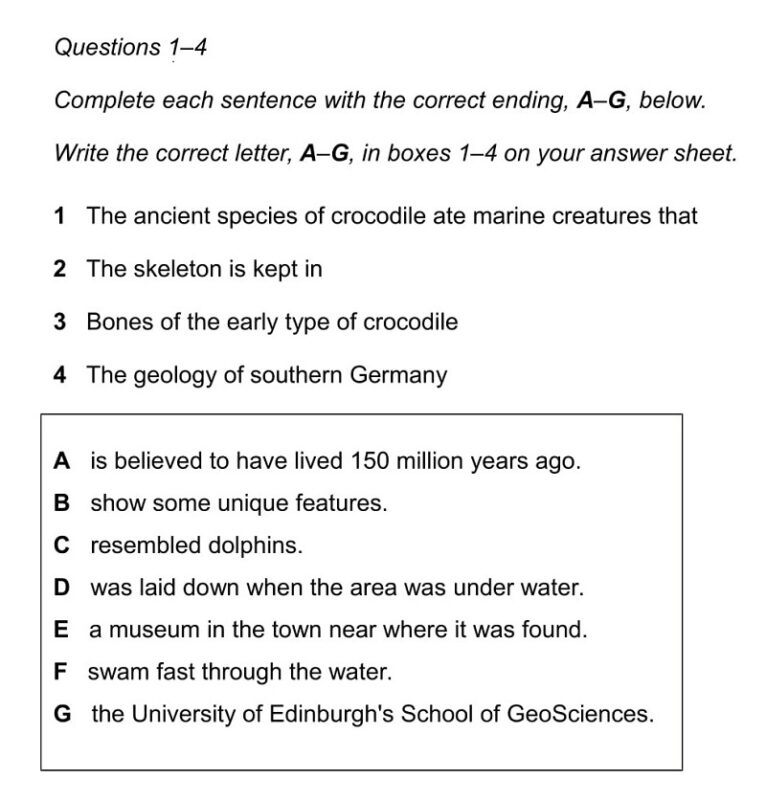Matching Sentence Endings là một trong những dạng bài của phần thi IELTS Reading. Đây là dạng bài không xuất hiện thường xuyên nhưng nếu không luyện tập và nắm chắc kiến thức thì khó thể đạt trọn vẹn điểm số. Hãy cùng The IELTS Workshop (TIW) tìm hiểu cách làm dạng bài Matching Sentence Endings sao cho nhanh chóng, hiệu quả và dễ dàng ghi điểm nhé.
1. Tổng quan dạng bài Matching Sentence Endings
1.1. Matching Sentence Endings là gì?
Matching Sentence Endings là dạng bài nối nửa câu được đề bài cho trước (đang thiếu mất phần ending) với nửa câu còn lại (sentence endings) sao cho tạo thành một câu văn có ý nghĩa và hợp lý dựa trên nội dung của bài đọc.

1.2. Các vấn đề khó khăn thường gặp trong dạng bài Matching Sentence Endings
- Số câu trả lời được cho trước thường nhiều hơn câu hỏi: Đề bài đưa ra rất nhiều thông tin gây nhiễu, có nội dung và keyword tương tự nhau nhằm đánh lạc thí sinh.
Gợi ý: Các bạn cần nắm ý chính xác hoàn toàn của đề và đáp án. Không nên chọn khi thấy mơ hồ. Còn khi có câu bị phân vân, sử dụng biện pháp loại trừ là thích hợp nhất.
- Không xác định được vị trí của nửa câu đầu tiên trong bài đọc: Vì nhiều thí sinh có suy nghĩ đọc trọn vẹn bài văn và cầu đề sẽ gây mất nhiều thời gian. Thay vào đó họ chỉ tập trung vào skim & scan keyword. Chính từ đây, dẫn đến trường hợp không xác định được nội dung, ý chính và vị trí của câu.
Gợi ý: Các câu hỏi được sắp xếp theo trình tự xuất hiện trước sau trong bài đọc. Nên chỉ cần đọc hiểu kỹ là không bị bỏ sót thông tin.
- Có thể xác định được vị trí nửa câu đầu nhưng không thể xác định được vị trí nửa câu sau: Nguyên nhân chính của trường hợp này là do đa phần thí sinh chỉ tập trung vào từ khóa, đọc lướt và nắm khái quát nội dung. Trong khi với dạng bài này, thông tin nằm rải rác khắp nơi trong bài đọc. Bên cạnh đó, các thông tin còn gây nhiễu rất nhiều khiến việc so sánh và chọn đáp án từ List of endings trở nên khó khăn.
Gợi ý:Tương tự như trên, bạn có thể áp dụng phương pháp skim & scan để hiểu rõ bài đọc và không bị bỏ qua bất kỳ thông tin trong bài.
2. Cách làm dạng bài Matching Sentence Endings
Dưới đây là chiến thuật làm bài Matching Sentence Endings trong IELTS Reading. Hãy nhớ rằng có rất nhiều cách làm bài khác nhau nên các bạn hãy lựa chọn ra cách làm nào phù hợp với mình nhất. Bạn cũng có thể áp dụng chiến thuật này sao cho phù hợp với phong cách của bản thân nhé.

Bước 1: Đọc kỹ đề bài và gạch chân từ khóa trong nửa câu đầu tiên.
Bạn cần nắm được nội dung chính của nửa câu đầu tiên
- Đọc lần lượt từng câu: Bạn cần nắm được nội dung chính của nửa câu đầu tiên. . Trong bước này, bạn không cần đọc đến List of endings (danh sách nửa câu sau). Chỉ tập trung vào các câu ở đề bài để tìm thông tin tương thích cho nhanh chóng.
- Gạch chân keywords và dự đoán: Hãy gạch chân các từ khóa chính (tên riêng, thuật ngữ, ngày tháng, danh từ…). Dựa vào đó, hãy tìm trong bài đọc có khả năng chứa thông tin liên quan.
Bước 2: Xác định thông tin tương thích được đề cập trong nửa câu đầu tiên và bài đọc
Dựa vào vị trí đã khoanh vùng ở Bước 1, hãy đọc kỹ phần bài đọc đã cho.
- Xác nhận thông tin: Tìm câu hoặc cụm từ trong bài đọc có chứa thông tin tương ứng với nửa câu đầu bạn đang xử lý. Hãy nhớ rằng bài đọc thường sẽ dùng từ đồng nghĩa (synonyms) hoặc diễn đạt lại (paraphrasing) chứ không dùng lại y hệt từ ngữ.
- Đọc và hiểu trọn vẹn ý: Đọc cả câu chứa thông tin đó và câu trước/sau nó để nắm bắt được ý nghĩa đầy đủ và chính xác nhất. Đừng vội chọn đáp án ngay.
Bước 3: Đọc hiểu kỹ thông tin trong bài
Đọc lướt hết cả bài bằng phương pháp skim & scan. Tiếp theo, đến những đoạn có chứa thông tin liên quan đến đề bài, cần đọc kỹ. Tránh được trường hợp bỏ sót các thông tin quan trọng.
Dựa trên thông tin bạn vừa hiểu được từ bài đọc, hãy thử tự mình hoàn thành nốt phần còn lại của câu trong đầu.
- Ví dụ: Nếu nửa câu đầu là “Early research showed that…” và trong bài đọc bạn tìm thấy thông tin “Các nghiên cứu ban đầu chỉ ra rằng phương pháp này tốn kém”, hãy tự hình dung phần kết sẽ là “…phương pháp này tốn kém”.
- Bây giờ, hãy đọc List of endings (A, B, C…) và tìm câu nào có ý nghĩa GẦN NHẤT với phần kết mà bạn vừa tự hình dung. Đây là cách hiệu quả nhất để tránh các bẫy gây nhiễu.
Bước 4: Tiến hành so sánh thông tin vừa tìm được trong bài với các câu trong List of endings.
Nếu có thông tin phù hợp thì bạn chọn ngay đáp án. Còn với trường hợp những câu gây phân vân, bạn hãy lần lượt loại trừ những đáp án không phù hợp để có thể hoàn thiện bài thi.
Xem thêm Các dạng và cách làm bài IELTS Reading chi tiết:
- 3 bước để True/ False/ Not Given trong IELTS Reading không bao giờ sai
- Hướng dẫn chi tiết cách làm bài Matching Heading trong IELTS Reading
- Hướng dẫn cách làm dạng bài Matching Features IELTS Reading
- Các lỗi thường gặp ở dạng bài IELTS Reading Multiple Choice
3. Các tips làm bài dạng Matching Sentence Endings
Đọc kỹ các nửa câu đã cho:
- Xác định từ khóa: Tìm các từ khóa quan trọng trong mỗi nửa câu để hiểu ý chính mà nó muốn truyền đạt.
- Dự đoán: Hãy cố gắng dự đoán nửa câu còn thiếu sẽ nói về điều gì dựa trên các từ khóa đã tìm được.
Đọc kỹ đoạn văn:
- Tìm ý chính: Xác định ý chính của mỗi đoạn văn.
- Liên kết các ý: Tìm kiếm các ý liên quan đến các nửa câu đã cho.
- Chú ý đến các từ nối: Các từ nối như “however”, “although“, “in addition” sẽ giúp bạn hiểu rõ hơn về mối quan hệ giữa các ý.
Nối các nửa câu:
- Đảm bảo về mặt ngữ pháp: Câu hoàn chỉnh phải đúng về mặt ngữ pháp.
- Đảm bảo về mặt ý nghĩa: Câu hoàn chỉnh phải có ý nghĩa hợp lý và phù hợp với nội dung của đoạn văn.
- Loại trừ các đáp án sai: Đôi khi, có những nửa câu nghe có vẻ hợp lý nhưng không chính xác hoàn toàn.
4. Ví dụ về dạng bài Matching Sentence Endings
4.1. Đề bài tham khảo
Waste disposal
Until now, Britain has opted for burying most of its rubbish. Around four fifths of municipal waste is sent to landfill sites. This approach has made considerate sense in an island with sites to spare because of its particular geology and its history of quarrying.
But landfill sites are getting scarce, particularly in southern England, where most people live. And they are becoming expensive to run as the government insists on safeguards against environmental hazards like the leaching of toxic waste into underground aquifers. But the biggest constraint on dumping stuff in landfill sites is Britain’s commitment to meet – about 60% of household rubbish – that is put into landfill sites. These targets are intended to cut emissions of methane (a greenhouse gas) and to reduce the risk of water contamination from landfill.
If you can’t bury it, an alternative is to burn it. This certainly seemed to be the initial thrust of government thinking a few years ago. A programme to build as many as 130 new incinerators was envisaged. But burning also entails environmental risks. Although new incinerators are now much cleaner than earlier ones, people are scared of exposure to dangerous chemicals like cancer-producing dioxins. The political difficulties in selling an expansion of incineration are immense.
Complete each sentence with the correct ending, A – G, below. Write the correct letter, A – G, in boxes 1 – 4 in your answer sheet.
1. The presence of old mines in Britain has
2. To make landfill sites safer, the authorities have
3. In order to comply with European targets, Britain has
4. Burning rubbish is not popular because people have
A. agreed to reduce waste levels.
B. destroyed most of the municipal waste.
C. encouraged rubbish burial.
D. released toxic waste
E. imposed safety laws.
G. become anxious about the pollution levels.
4.2. Hướng dẫn làm bài chi tiết
Bước 1. Gạch chân từ khóa cho sẵn
Nhìn vào câu 1 và 3, chúng ta có các từ khóa như “old mines” và “Britain”.
Bước 2. Sử dụng từ khóa để xác định đoạn thông tin trong bài đọc:
Ta có Britain ngay trong câu đầu tiên.
Tiếp đến, “old mines” đã được paraphrase thành “quarrying”, và tác giả đã biến nó thành cụm “history of quarrying – lịch sử làm mỏ”. Từ đó, có thể suy ra, thông tin của câu 1 nằm ở đoạn đầu tiên.
Bước 3. Sau khi xác định được vị trí của thông tin, ta tiến hành đọc hiểu.
Đoạn văn nói: “Cho đến bây giờ, nước Anh đã chọn chôn đa phần rác thải. 4/5 rác thải công cộng được gửi đến các bãi chứa rác. Các thức này khá hợp lý với một hòn đảo với nhiều đất trống vì vị trí địa lý đặc biệt cũng như lịch sử làm mỏ của nó.”
Bước 4. Đọc các đuôi và xác định từ khóa.
Đuôi thứ 1, “agreed to….” nếu ghép vào câu cho sẵn hoàn toàn không hợp nghĩa của câu. Sự hiện diện của các mỏ cũ không thể đồng ý làm gì đó.
Đuôi thứ 2, có từ khóa “incinerators” hoàn toàn không được nhắc đến.
Đuôi thứ 3, không có thông tin về việc “destroy municipal garbage”
Đuôi thứ 4, có từ khóa “burial” là danh từ của động từ bury. Ta có thể tạm thời để lại.
Đuôi thứ 5, 6 và 7 hoàn toàn không có thông tin về việc “release toxic waste, impose safety laws, become anxious about the environment level”.
Từ đó, ta có thể loại trừ đáp án thứ 4. Phân tích cụ thể hơn, ta có thể thấy, việc có lịch sử làm mỏ đã khiến cho “this approach” – “việc chôn rác” (burial) trở nên hợp lí với hòn đảo này.
5. Bài tập về Matching Sentence Endings
Great Migrations
Animal migration, however it is defined, is far more than just the movement of animals. It can loosely be described as travel that takes place at regular intervals – often in an annual cycle – that may involve many members of a species, and is rewarded only after a long journey. It suggests inherited instinct. The biologist Hugh Dingle has identified five characteristics that apply, in varying degrees and combinations, to all migrations. They are prolonged movements that carry animals outside familiar habitats; they tend to be linear, not zigzaggy; they involve special behaviours concerning preparation (such as overfeeding) and arrival; they demand special allocations of energy. And one more: migrating animals maintain an intense attentiveness to the greater mission, which keeps them undistracted by temptations and undeterred by challenges that would turn other animals aside.
An arctic tern, on its 20,000 km flight from the extreme south of South America to the Arctic circle, will take no notice of a nice smelly herring offered from a bird-watcher’s boat along the way. While local gulls will dive voraciously for such handouts, the tern flies on.
Why? The arctic tern resists distraction because it is driven at that moment by an instinctive sense of something we humans find admirable: larger purpose. In other words, it is determined to reach its destination. The bird senses that it can eat, rest and mate later. Right now it is totally focused on the journey; its undivided intent is arrival.
Reaching some gravelly coastline in the Arctic, upon which other arctic terns have converged, will serve its larger purpose as shaped by evolution: finding a place, a time, and a set of circumstances in which it can successfully hatch and rear offspring.
But migration is a complex issue, and biologists define it differently, depending in part on what sorts of animals they study. Joe! Berger, of the University of Montana, who works on the American pronghorn and other large terrestrial mammals, prefers what he calls a simple, practical definition suited to his beasts: ‘movements from a seasonal home area away to another home area and back again’. Generally the reason for such seasonal back- and-forth movement is to seek resources that aren’t available within a single area year- round.
But daily vertical movements by zooplankton in the ocean – upward by night to seek food, downward by day to escape predators – can also be considered migration. So can the movement of aphids when, having depleted the young leaves on one food plant, their offspring then fly onward to a different host plant, with no one aphid ever returning to where it started.
Dingle is an evolutionary biologist who studies insects. His definition is more intricate than Berger’s, citing those five features that distinguish migration from other forms of movement. They allow for the fact that, for example, aphids will become sensitive to blue light (from the sky) when it’s time for takeoff on their big journey, and sensitive to yellow light (reflected from tender young leaves) when it’s appropriate to land. Birds will fatten themselves with heavy feeding in advance of a long migrational flight. The value of his definition, Dingle argues, is that it focuses attention on what the phenomenon of wildebeest migration shares with the phenomenon of the aphids, and therefore helps guide researchers towards understanding how evolution has produced them all.
Human behaviour, however, is having a detrimental impact on animal migration. The pronghorn, which resembles an antelope, though they are unrelated, is the fastest land mammal of the New World. One population, which spends the summer in the mountainous Grand Teton National Park of the western USA, follows a narrow route from its summer range in the mountains, across a river, and down onto the plains. Here they wait out the frozen months, feeding mainly on sagebrush blown clear of snow. These pronghorn are notable for the invariance of their migration route and the severity of its constriction at three bottlenecks. If they can’t pass through each of the three during their spring migration, they can’t reach their bounty of summer grazing; if they can’t pass through again in autumn, escaping south onto those windblown plains, they are likely to die trying to overwinter in the deep snow. Pronghorn, dependent on distance vision and speed to keep safe from predators, traverse high, open shoulders of land, where they can see and run. At one of the bottlenecks, forested hills rise to form a V, leaving a corridor of open ground only about 150 metres wide, filled with private homes. Increasing development is leading toward a crisis for the pronghorn, threatening to choke off their passageway.
Conservation scientists, along with some biologists and land managers within the USA’s National Park Service and other agencies, are now working to preserve migrational behaviours, not just species and habitats. A National Forest has recognised the path of the pronghorn, much of which passes across its land, as a protected migration corridor. But neither the Forest Service nor the Park Service can control what happens on private land at a bottleneck. And with certain other migrating species, the challenge is complicated further – by vastly greater distances traversed, more jurisdictions, more borders, more dangers along the way. We will require wisdom and resoluteness to ensure that migrating species can continue their journeying a while longer.

Đáp án
19 – G
20 – C
21 – A
22 – E
Trên đây là một số bí kíp cho dạng bài Matching Sentence Endings đặc biệt hữu hiệu cho những ai đang ôn luyện Reading. Chúc các bạn sớm chinh phục được dạng bài tập này. Tham khảo khóa học Junior tại The IELTS Workshop để biết phương pháp ôn luyện toàn diện cho kỹ năng Reading nói riêng và IELTS nói chung.









